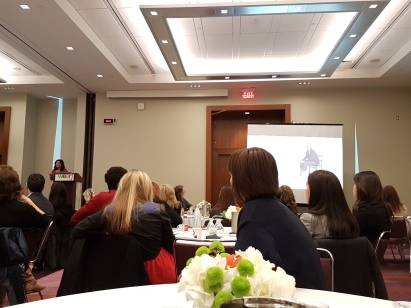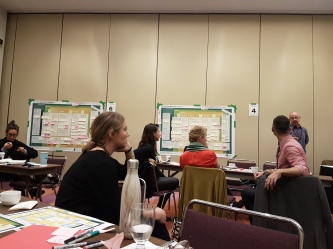Last week a non-profit group, Fashion Take Action, organized a conference to gather different audiences from industry leaders to independent designers to master students.  Three themes were set out: Textile Waste, Innovation and Supply Chain (transparency). The conference kicked off with Safia Minney, Author and founder of People Tree UK & Japan) and was present in the documentary, The True Cost (see my film review here). She makes note that the clothing industry is the 2nd largest polluter in the world and to tie it in 78% of the poor depend on agriculture (as per the World Bank). This lead for her to create her company PeopleTree – a company that focuses on “slow fertility” through organic agriculture.
Three themes were set out: Textile Waste, Innovation and Supply Chain (transparency). The conference kicked off with Safia Minney, Author and founder of People Tree UK & Japan) and was present in the documentary, The True Cost (see my film review here). She makes note that the clothing industry is the 2nd largest polluter in the world and to tie it in 78% of the poor depend on agriculture (as per the World Bank). This lead for her to create her company PeopleTree – a company that focuses on “slow fertility” through organic agriculture.

The conference was covered in 2 days. Day 1 consisted of 4 panel discussions and Day 2 were your choice of 2 workshops. All attendees were divided up into Stream A (Designers, Brands, Academia and Students) or B (Supply Chain, Corporate Brands, NGOs and Government). But here’s the actual meat of the conference…
What I Learned (skip along to the headings that interest you):
- Fashion Detox: Chemical Risks:
- The concept of fashion detox – understanding chemical risks will help enhance brand image because it targets on health, environment and sustainability
- The challenges are when textile + electronics + metals are all crossed over and become one thing in fashion. How does one expect to break this down properly?
- There should be pre-qualification processes in place and contractual agreements before a company can sell the merchandise. This would also help create an incentive for suppliers to change their way of product creation.
- Consulting/Factory Audits:
- Health and Safety + Wages and Hours are the top rated issues found in a factory audit amongst factories.
- One must WORK with the factory in order to address the problems. That is the only solution.
- “Comply or Die” method is not sustainable
- HIGG Index 2.0:
- Can be used for factories to benchmark against one another
- H&M currently uses this as part of the Sustainable Apparel Coalition
 Product Innovation:
Product Innovation:
- Lululemon states they are able to recycle 98% of their waste. Their main concerns are now bags and coats because they are comprised of too many different materials.
- We need to invest in good quality because once it’s recycled, the good quality is back into the chain.
- Three main pillars to innovation as per Recycling Council of Ontario (RCO): (1) Policy & Advocacy (2) Research & Pilot the Project (3) Program Development & Management
- We need to move towards recycling solutions for returns, defects, pullbacks and liability. The general consensus of global recover-ability is needed to sustain the things we use.
- Donation Bins to Divert Textile:Value Village VP – Supply Chain Operations, Tony Shumpert found 3 things about apparel:
- 1) People have too much stuff
2) Concept of donation is used…but people are still throwing away 3 bags of clothes for every 1 bag they donate
3) Two factors for why people donate clothing: 1) Closets are overflowing (acts as a reminder) and 2) their weight fluctuation
- 1) People have too much stuff
 City of Markham – Things done right:
City of Markham – Things done right:
- Donating clothing is not for charity but more so convenient.
- Some people throw or donate based on the brand of the clothing – there seems to be an ethnic gap in awareness and clothing appreciation.
- ACTION: Looking to ban textiles from Garbage in April 2017 (WOW!) with a strong focus on extensive education and promotion. They are looking to prohibit unregulated donation bins (to minimise people throwing anything away or digging through them). They are looking to lobby the provincial government to declare textile as stewardship and more responsibility will be placed on consumers.
- Textile Waste:
- In 1983 Maytag had a lint trap for washing clothes (not just drying) but this stopped. The problem with lint from washing are the synthetic fibers that become “microfiber pollution” or aka “plastic smog”. This is similiar to the ban on microbeads – things you can’t see but it’s there. We are doing this to our own water!
Things I didn’t Agree with:
- GAP – they mentioned the need to translate the Western HR methods to the Eastern Vendors. What works here doesn’t necessarily play out over there and I don’t believe in translating any method when there is a lack of understanding of their social economic means and why they run business the way they do. No root cause – don’t try to make your way, their way.
- It’s contradicting when you have a clothing company like H&M state they want a closed loop program but when you’re known as a company of “fast fashion” – it’s quite counterproductive. Focusing solely on textiles but what about the cost of operation (environmentally and economically) when you’re producing the clothing?!
Overall – A great event where you meet so many different walks of life. I met a girl that is working on de-genderizing clothing, a few of them were also re-creating clothing from donated/scrap material to companies that are looking for products that often don’t get sold, to be re-sold back into their market. If there’s a future opportunity to attend, I would advise it.
To Ponder On: How will you contribute to changing the way you purchase, make and/or donate apparel?
Photosource: Los Angeles Times


